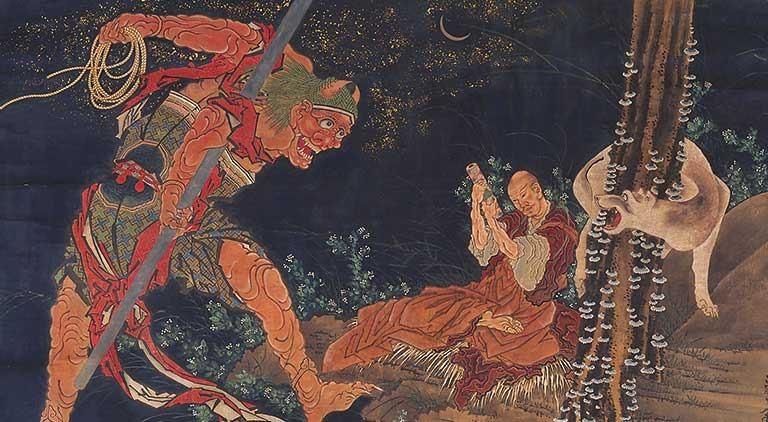Oni – The Iconic Demons of Japanese Folklore
Oni (鬼, pronounced “oh-nee”) are legendary creatures deeply rooted in Japanese folklore. Often depicted as fierce, powerful demons with horns and wild hair, Oni have been part of Japan’s cultural and religious history for centuries. While commonly portrayed as fearsome and malevolent, Oni have also been seen as protectors, deities, and symbols of natural forces.
Overview of Oni
Today’s popular image of an Kuro Oni (black Oni). These color associations are influenced by ancient elemental theories, blending aspects of the five elements (wood, fire, earth, metal, and water) with traditional Buddhist ideas.
Historically, Oni have been envisioned as the fearsome jailors of Hell, serving under the authority of Yama, the King of the Underworld. In some legends, they are even named with the suffix “-doji” (child), as seen in the famous tale of Shuten-dōji, the notorious leader of a band of Oni.
Diverse Interpretations and Theories
Japanese folklore does not offer a single, fixed image of Oni. Over time, their roles and characteristics have evolved:
- Folk Spirits and Earth Deities: In some regions, Oni are revered as ancestral or land spirits, guarding mountains and natural landscapes.
- Mountain and Ascetic Spirits: Some traditions link Oni with mountain ascetics and spiritual warriors, such as the yamabushi, who embrace the wild energy of the mountains.
- Buddhist Influences: In Buddhist teachings, Oni are often portrayed as tormentors in Hell or as embodiments of greed and desire, sometimes even transforming into hungry spirits known as “gaki” (餓鬼) after death.
- Human Transformations: There are also stories where humans, overcome by envy or rage, transform into Oni. In traditional Noh plays like “Tsurukame” and “Momijigari,” characters become Oni as a result of intense negative emotions.
Cultural historian Akiko Baba and other scholars have classified Oni into several types, ranging from ancestral and mountain spirits to vengeful ghosts and transformed humans. This variety explains why Oni continue to fascinate both traditional and modern audiences.
The Origins and Etymology of Oni
The Japanese word Genji Monogatari and ancient poems, these spirits—often filled with resentment or curse—were described as “mono.” Over time, as the image of Oni absorbed Buddhist and local beliefs, the word evolved into “oni,” encapsulating the broad spectrum of these supernatural beings.
The Relationship Between Humans and Oni
Oni are not simply evil monsters; they embody complex interactions between the human and supernatural worlds. While many stories tell of Oni disguising themselves as humans to terrorize unsuspecting victims, others describe how deep-seated human emotions like jealousy and hatred can transform ordinary people into Oni. For instance, in some Noh plays and folktales, a woman’s overwhelming jealousy might lead her to become an Oni, forever marked by her transformation.
This duality makes Oni a compelling symbol in Japanese culture—both a warning against uncontrolled emotions and a representation of the mysterious forces that blur the line between good and evil.
Oni in Buddhist Tradition
In Buddhist cosmology, Oni have several roles:
- Hungry Ghosts (Gaki): Those who indulged in greed or gluttony during their lives are reborn as gaki, wandering the world in constant torment.
- Hell Guardians: In many depictions, Oni serve as the guards of Hell, executing the judgments of Yama.
- Heianagi-Iwashi.”
These varied interpretations highlight how Oni can represent both danger and protection, a dual nature that continues to captivate audiences worldwide.
What Oni Fear
Legends also tell us that Oni have their own vulnerabilities. They are said to dislike:
- Strong Odors: The pungent smell of certain foods, especially the smoke and aroma released when grilling sardines, is believed to repel Oni.
- Sharp Objects: Spiky items, such as the thorns from holly leaves, are thought to be capable of injuring or warding off these demons.
During seasonal transitions, particularly on Setsubun, households place holly branches and smoke sardines to scare away Oni and protect against misfortune.
Conclusion
The multifaceted nature of the Oni—ranging from terrifying demons to revered spirits—reflects the rich tapestry of Japanese folklore and religious thought. Whether you are a longtime fan of Japanese mythology or a newcomer intrigued by these otherworldly beings, the legend of the Oni offers endless layers of meaning and mystery. Explore more about Oni and Japanese folklore to discover a world where the boundary between the human and the supernatural is as fluid as it is fascinating.
Reference:Wikipedia – 鬼


Comments